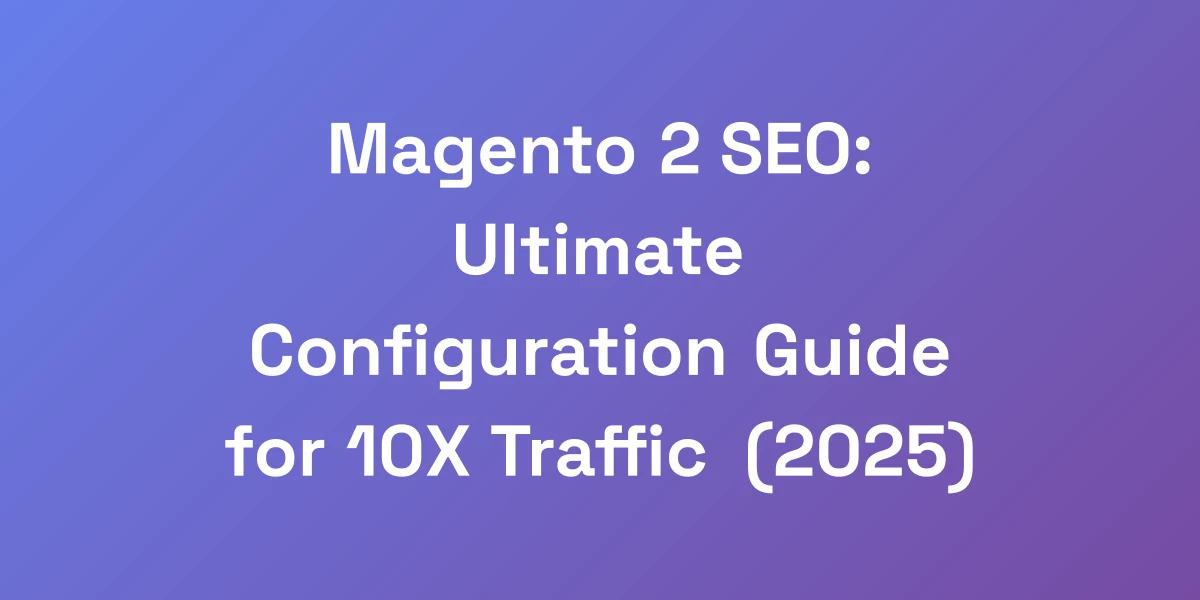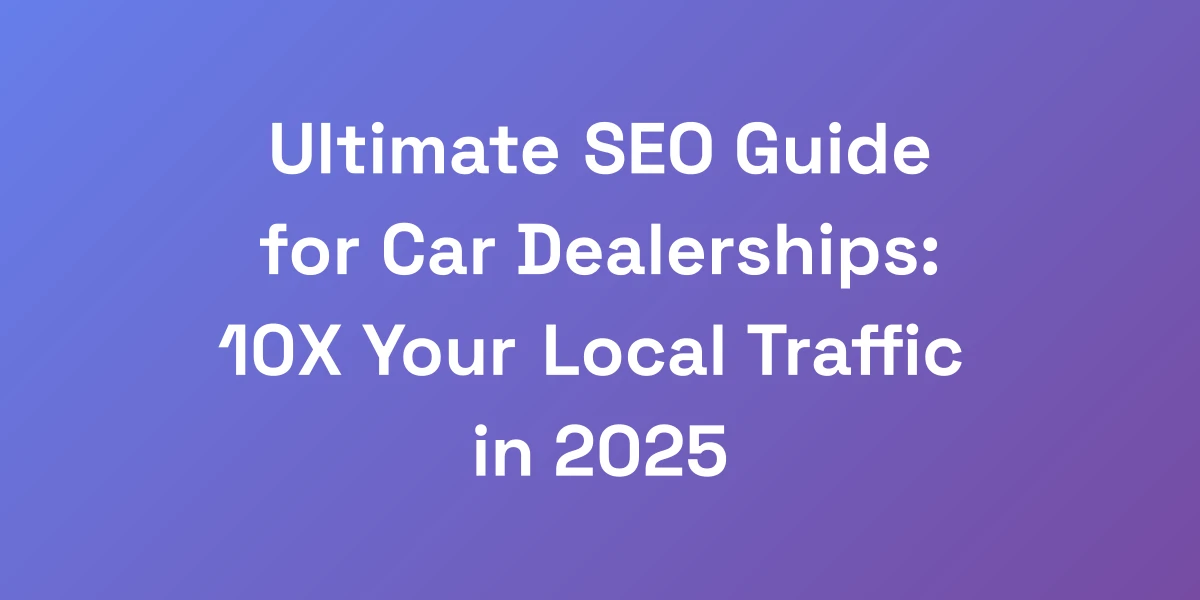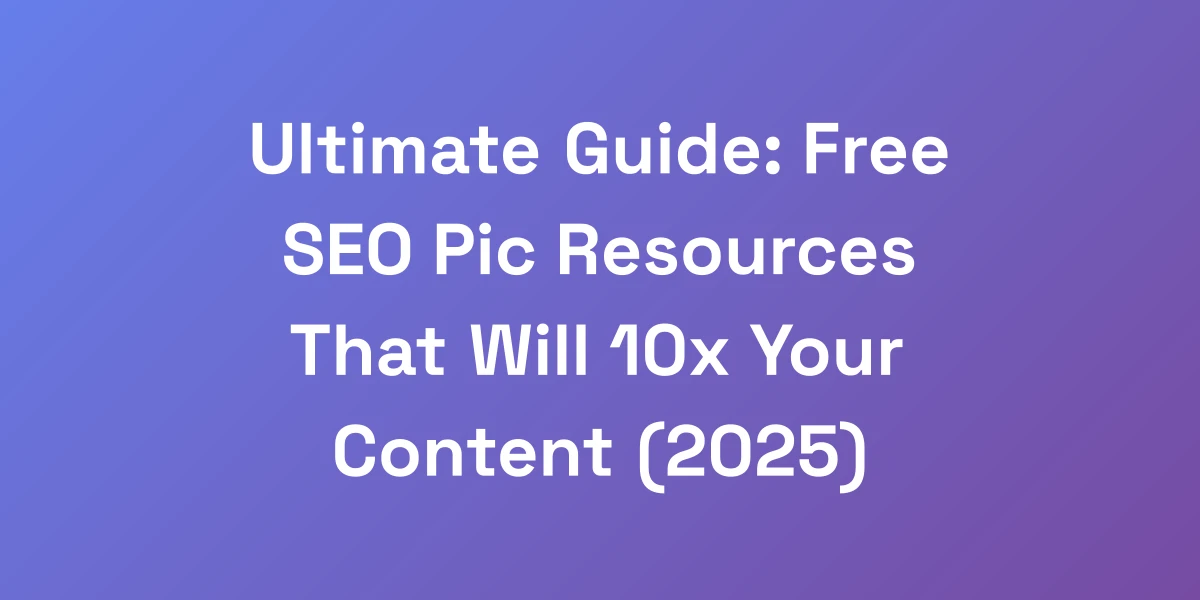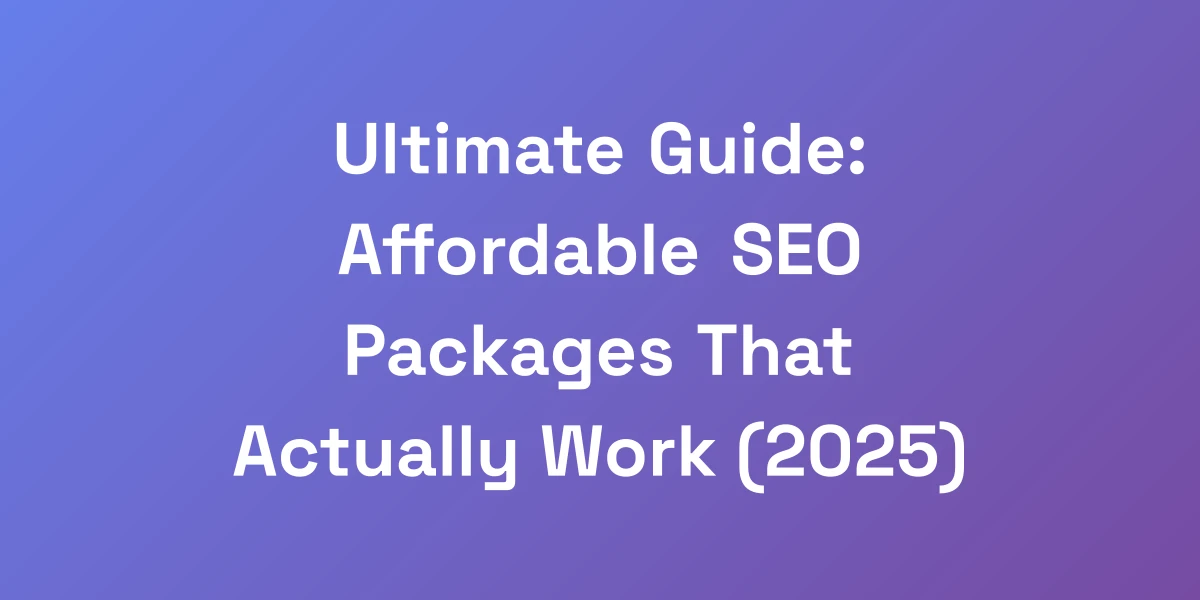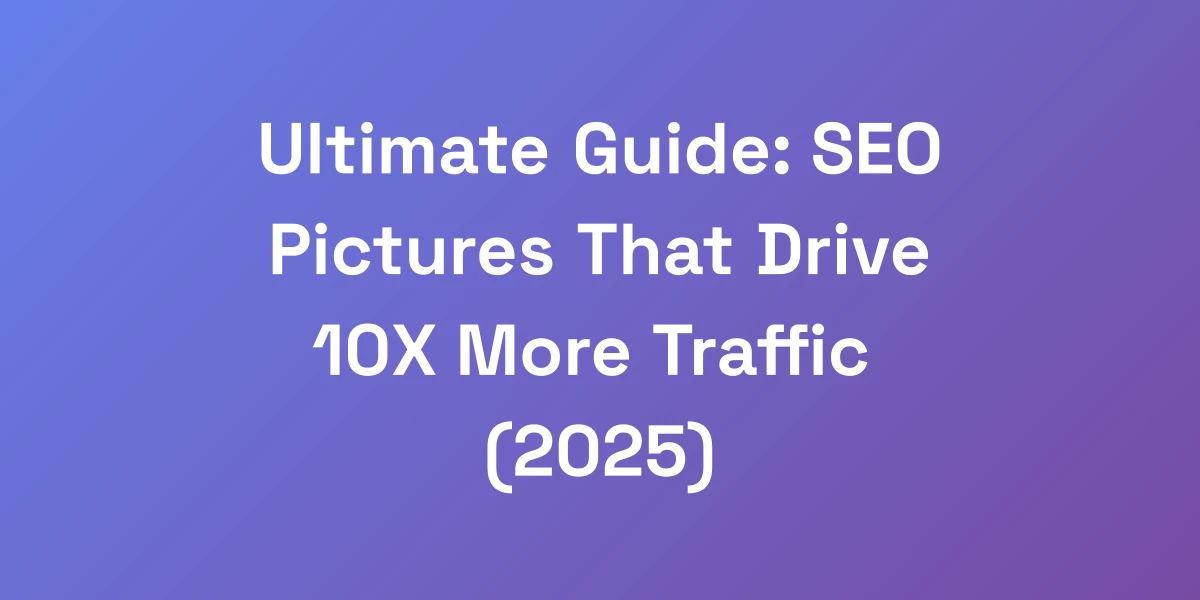
Ultimate Guide: SEO Pictures That Drive 10X More Traffic (2025)
Mar 5, 2025 | By [email protected]
Why Most Websites Fail at Image SEO (And How to Win)
Let us hit you with some truth: 93% of websites are leaving money on the table because they don’t understand image SEO. We’ve generated over $100M in revenue, and we can tell you—the right SEO pictures aren’t just “nice to have.” They’re a competitive advantage that most people completely miss.
Here’s the thing: when you optimize your images correctly, you’re not just making your site look pretty—you’re creating multiple new entry points for traffic. Are you ready to turn your images into traffic-generating machines? Let us show you exactly how.
The Hidden Cost of Poor Image Optimization
Imagine pouring resources into your website’s design, but your images are dragging everything down. Poor image optimization can lead to:
- Slow Loading Times: Visitors abandon sites that take too long to load.
- Reduced Search Visibility: Unoptimized images miss out on search engine rankings.
- Higher Bounce Rates: Users leave when they don’t find what they’re looking for quickly.
Every second counts in keeping your audience engaged. If your images aren’t optimized, you’re essentially handing over your traffic to competitors.
What’s the real cost? It’s not just lost views—it’s lost revenue. Think about how many visitors you’re letting slip away because your images aren’t up to par.
How Google’s Image Algorithm Really Works
Google’s image algorithm is more sophisticated than ever. It doesn’t just look at keywords; it understands context, relevance, and quality. Here’s what you need to know:
- Contextual Relevance: Images need to be relevant to the surrounding text.
- Descriptive Alt Text: Accurate descriptions help Google index your images.
- High-Quality Files: Clear, high-resolution images rank better.
Understanding these factors is crucial. It’s not enough to just throw images on your site—you need to integrate them thoughtfully into your SEO Starter Guide.
The Traffic-Value Formula for Images
How can you quantify the value your images bring? Here’s a simple formula:
- Visibility: How visible your image is in search results.
- CTR: The click-through rate your image generates.
- Conversion: The actions users take after clicking through.
Multiply these factors together, and you have a clear picture of the traffic your SEO pictures can drive. It’s not just about getting eyes on your images—it’s about turning those views into valuable traffic.
Case Study: How One Site 3X’d Traffic Through Images
Take the example of ZOE, a digital health platform. By optimizing their images with descriptive alt text, keyword-rich file names, and informative title tags, they achieved a staggering 72,100 image snippets. This optimization strategy tripled their traffic within months.
What did they do differently? They treated images as integral parts of their SEO case studies, not just decorative elements. Each image was strategically placed and optimized to enhance both user experience and search visibility.
Are you ready to replicate ZOE’s success? It starts with a focused approach to image SEO.
Common Image SEO Myths Debunked
Let’s bust some myths that might be holding you back:
- Myth 1: Image SEO is not important.
- Myth 2: Only large websites need image SEO.
- Myth 3: Alt text is optional.
The truth? Image SEO matters for websites of all sizes, and every element—from alt text to file names—plays a critical role in driving traffic. Don’t let these misconceptions keep you from leveraging a powerful SEO tool.
The Perfect SEO Picture Formula (Step-by-Step Blueprint)
Stop wasting time with outdated image optimization tactics. We’re going to give you the exact formula we use across our portfolio companies that generates consistent results. This isn’t theory—it’s battle-tested across millions in ad spend and countless websites.
The key is understanding that image optimization is a system, not a series of random tactics. When you implement this formula, you’re not just checking boxes—you’re creating a SEO optimization automation system that keeps delivering results long-term.
Selecting High-Impact Images That Convert
Choosing the right images can make or break your SEO strategy. Here’s how to select high-impact images:
- Relevance: Ensure the image is directly related to the content.
- Quality: Use high-resolution images that load quickly.
- Uniqueness: Opt for unique images to stand out in search results.
For example, stock images are widely used, but custom images tailored to your brand can significantly enhance user engagement and SEO performance. Similarly, understanding content marketing for small businesses involves selecting images that resonate with your target audience.
Optimization Checklist (With Examples)
Here’s a comprehensive checklist to ensure your images are fully optimized:
- File Name: Use descriptive, keyword-rich file names. Instead of “IMG1234.jpg,” use “seo-optimized-marketing.jpg.”
- Alt Text: Write clear, concise alt text that describes the image and includes relevant keywords.
- Title Tag: Add a title tag that provides additional context and keywords.
- Caption: Use captions to enhance relevance and provide more information.
- File Size: Compress images without sacrificing quality to improve load times.
For instance, ZOE’s image optimization followed each of these steps meticulously, resulting in a significant boost in their image search rankings and overall traffic.
File Naming Convention That Ranks
Your image file names are more powerful than you think. Here’s how to name them for maximum SEO impact:
- Be Descriptive: Clearly describe the image content.
- Use Hyphens: Separate words with hyphens, not underscores. Example: “blue-widget.jpg” instead of “blue_widget.jpg.”
- Include Keywords: Naturally incorporate relevant keywords without keyword stuffing.
Remember, a well-named file helps search engines understand what the image is about, enhancing your chances of appearing in relevant search results.
Alt Text That Drives Traffic
Alt text serves multiple purposes: accessibility, user experience, and SEO. Here’s how to write alt text that drives traffic:
- Be Descriptive: Describe the image accurately and thoroughly.
- Include Keywords: Integrate primary keywords naturally.
- Avoid Keyword Stuffing: Keep it readable and relevant.
For example, instead of “image of a graph,” use “growth graph showing 10X traffic increase through SEO pictures.” This not only describes the image but also integrates key terms that boost SEO.
Advanced Compression Techniques
Optimization isn’t just about naming; it’s also about making your images as efficient as possible. Here are advanced compression techniques:
- Use Modern Formats: WebP and AVIF offer superior compression rates without losing quality.
- Leverage Compression Tools: Tools like TinyPNG, ImageOptim, and ShortPixel can significantly reduce file sizes.
- Balance Quality and Size: Find the sweet spot where image quality remains high while file size is minimal.
Implementing these techniques ensures your images load quickly, improving user experience and SEO rankings. Learn more about the role of image compression in SEO.
Schema Markup Secrets
Schema markup can elevate your image SEO by providing additional context to search engines. Here’s how to use it effectively:
- ImageObject Schema: Use this schema to provide detailed information about your images.
- Integrate with Content: Ensure schema markup is relevant to the surrounding content.
- Test Your Markup: Use Google’s Structured Data Testing Tool to verify your schema markup.
By adding schema markup, you enhance the visibility and relevance of your images in search results, potentially leading to higher rankings and more traffic.
Top Sources for High-Converting SEO Pictures (Free & Premium)
We’re going to share something that took us years and millions of dollars to learn: where you source your images matters more than how you optimize them. Most people waste hours on optimization when they’re starting with the wrong images. We’ll show you exactly where to find images that are not just “SEO-friendly” but are pre-optimized for conversion.
These are the same sources we use across our 8-figure businesses, and they’re about to become your secret weapon.
Premium Sources Worth Every Penny
Investing in premium image sources can be a game-changer. Here are some top options:
- Shutterstock: Offers a vast library of high-quality, unique images suitable for any niche.
- Getty Images: Known for its extensive collection and superior image quality.
- Adobe Stock: Integrates seamlessly with Adobe products, making it ideal for creative projects.
These platforms provide premium images that are less likely to be used by multiple sites, giving your content a unique edge in search results.
Hidden Free Image Repositories
Not ready to invest? These free repositories offer high-quality images that can still boost your SEO:
- Unsplash: A vast collection of free, high-resolution images.
- Pexels: Offers a wide range of free stock photos and videos.
- Pixabay: Provides over 1.7 million free images and videos.
While free sources are limited in uniqueness, using them strategically with proper optimization can still yield impressive SEO results.
Custom Creation Tools
If you need something truly unique, consider creating your own images. Here are some tools to help:
- Canva: User-friendly design tool with templates for creating custom images.
- Adobe Photoshop: Advanced tool for creating and editing high-quality images.
- Figma: Great for collaborative design and creating custom graphics.
Creating your own images ensures uniqueness and relevance to your brand, enhancing both user engagement and SEO performance.
Legal Considerations and Licensing
Using images without proper licensing can lead to legal issues. Here’s what you need to keep in mind:
- Understand Licensing Terms: Always check the licensing agreements of the image sources you use.
- Attribute When Necessary: Some free images require attribution, so make sure to comply.
- Avoid Copyrighted Material: Ensure you have the right to use and modify the images you choose.
Proper licensing not only keeps you legally safe but also maintains the integrity and professionalism of your website.
Quality Assessment Framework
To ensure your images meet quality standards, use this assessment framework:
- Resolution: Images should be high-resolution without being unnecessarily large in file size.
- Relevance: Each image should directly support the content it accompanies.
- Aesthetic Appeal: High-quality visuals increase user engagement and credibility.
Regularly evaluate your image quality to maintain a professional and SEO-friendly website.
Bulk Download Strategies
When dealing with large volumes of images, efficiency is key. Here are some strategies:
- Use Download Managers: Tools like DownThemAll or Internet Download Manager can speed up the process.
- Automate with Scripts: For advanced users, writing scripts to automate image downloads can save time.
- Plan Your Collections: Organize images into categories before downloading to streamline the process.
Efficient bulk downloading ensures you have the right images ready for optimization, saving you time and effort.
Advanced Image SEO Tactics That 99% Don’t Know
Here’s what separates the amateurs from the pros: understanding that image SEO isn’t just about optimization—it’s about strategic leverage. We’re going to share tactics that most “SEO experts” have never even heard of. These are the same strategies we use to dominate competitive niches. The best part? While your competitors are still focusing on basic optimization, you’ll be building unstoppable momentum with these advanced techniques.
Image Sitemap Optimization
Image sitemaps are essential for ensuring all your images are indexed by search engines. Here’s how to optimize them:
- Create a Dedicated Image Sitemap: Include only image URLs to streamline the crawling process.
- Include Relevant Metadata: Add information like captions and titles to each image entry.
- Regularly Update Your Sitemap: Ensure your sitemap reflects any new or updated images.
Optimized image sitemaps enhance search engine visibility, ensuring your images contribute effectively to your SEO strategy. Incorporating SEO automation tools can further streamline this process.
CDN Configuration Secrets
Content Delivery Networks (CDNs) can dramatically improve image delivery. Here’s how to configure them for optimal SEO:
- Select the Right CDN: Choose a CDN like Cloudflare or Fastly that offers excellent performance and reliability.
- Enable Image Caching: Proper caching reduces load times by storing images closer to your users.
- Optimize CDN Settings: Configure settings to serve images in modern formats and automatically adjust quality based on device.
With the right CDN configuration, your images load faster, improving user experience and boosting your search rankings.
Lazy Loading Implementation
Lazy loading significantly enhances page speed by loading images only when they enter the viewport. Here’s how to implement it:
- Use Native Lazy Loading: Modern browsers support the ‘loading=”lazy”‘ attribute. Simply add this to your
<img>tags. - Leverage JavaScript Libraries: Tools like LazyLoad can offer more customization and compatibility.
- Combine with Other Optimization Techniques: Ensure lazy-loaded images are also compressed and use appropriate formats.
Implementing lazy loading improves load times, reduces bandwidth usage, and enhances the overall user experience.
Mobile-First Image Strategies
With mobile internet usage skyrocketing, optimizing images for mobile is non-negotiable. Here’s how:
- Use Responsive Images: Implement the
srcsetattribute to serve different images based on device. - Optimize for Mobile Speed: Ensure images load quickly on mobile networks by reducing file sizes and using efficient formats like WebP.
- Prioritize Above-the-Fold Content: Load critical images first to improve perceived speed and user experience.
Mobile-first strategies ensure your images deliver a seamless experience across all devices, which is crucial for both user retention and SEO.
Image Search Console Mastery
Google Search Console provides valuable insights into your image performance. Here’s how to master it:
- Monitor Image Performance: Use the Performance report to track impressions, clicks, and CTR for your images.
- Identify Issues: Check for any indexing errors or issues with specific images.
- Optimize Based on Data: Use the insights to refine your image SEO strategies, focusing on what’s driving the most traffic.
Leveraging Search Console helps you make data-driven decisions, ensuring your image SEO efforts are effective and continuously improving.
Future-Proofing Your Image SEO
SEO is always evolving, and staying ahead requires anticipating future trends. Here’s how to future-proof your image SEO:
- Adopt Next-Gen Formats: Stay updated on emerging formats like AVIF for better compression and quality.
- Integrate AI and Machine Learning: Use AI tools to automate image tagging and enhance optimization.
- Stay Informed on Algorithm Changes: Regularly monitor Google’s updates to adjust your strategies accordingly.
By preparing for future developments, you ensure your image SEO remains robust and continues to drive traffic long-term.
Measuring and Scaling Your Image SEO Success
Listen closely: if you’re not measuring, you’re just guessing. But here’s the thing—most people measure the wrong metrics when it comes to image SEO. We’re going to show you exactly what to track and how to scale what’s working.
We’ve used this exact system to scale multiple businesses past 7-figures, and it all starts with knowing your numbers. The real magic happens when you can replicate and scale your successes systematically.
Key Performance Indicators
To measure the success of your image SEO efforts, focus on these KPIs:
- Image CTR: Percentage of users who click on your image from search results.
- Organic Traffic from Images: Total visitors driven to your site through image search.
- Conversion Rates: Actions taken by users after clicking on your images, such as purchases or sign-ups.
Tracking these indicators provides a clear picture of how your images contribute to overall SEO performance and business goals.
Analytics Setup Guide
Setting up analytics correctly is crucial for accurate measurement. Follow these steps:
- Integrate Google Analytics: Make sure your website is connected to Google Analytics for comprehensive tracking.
- Set Up Image-Specific Goals: Define goals related to image interactions, such as clicks or conversions.
- Use UTM Parameters: Apply UTM tags to image URLs to track their performance specifically.
A well-configured analytics setup ensures you capture all relevant data, allowing for informed decision-making and strategic adjustments.
Scaling Successful Images
Once you identify which images are performing well, it’s time to scale their success:
- Replicate High-Performing Strategies: Apply the same optimization techniques to other images on your site.
- Increase Image Volume: Add more high-quality, optimized images to relevant sections of your website.
- Expand to New Platforms: Use successful images across various platforms like social media and email marketing to boost traffic further.
Scaling ensures that the momentum you’ve built continues to drive traffic and conversions, maximizing the return on your image SEO efforts. Explore actionable SEO tips to further enhance your strategy.
Automation Tools and Processes
Efficiency is key when scaling. Here are some tools and processes to automate your image SEO:
- Automated Compression: Use tools like ShortPixel or Kraken.io to automatically compress images upon upload.
- Batch Optimization: Optimize multiple images at once using batch processing features in tools like ImageOptim.
- Automated Tagging: Implement AI tools to automatically generate alt text and other metadata for your images.
Additionally, leveraging search engine optimization automation solutions can significantly enhance your optimization workflows.
ROI Calculation Framework
Understanding the return on investment (ROI) of your image SEO is essential. Use this framework:
- Identify Costs: Calculate expenses related to image sourcing, optimization tools, and time spent.
- Measure Revenue: Track the revenue directly attributed to traffic generated by image SEO efforts.
- Calculate ROI: Use the formula (Revenue – Costs) / Costs to determine your ROI.
By quantifying your ROI, you can justify investments in image SEO and allocate resources more effectively.
Monthly Maintenance Checklist
To keep your image SEO in top shape, implement a monthly maintenance routine:
- Review Performance Metrics: Analyze your KPIs to identify any changes or trends.
- Update and Refresh Images: Replace underperforming images with new, optimized ones.
- Check for Technical Issues: Ensure all images are loading correctly and there are no broken links.
Regular maintenance ensures your image SEO remains effective and continues to drive traffic consistently.
Conclusion
We’ve journeyed through the intricate landscape of SEO pictures, uncovering why most websites falter and how you can stand out. From debunking common myths to implementing advanced tactics, the power of image SEO is undeniable.
The key takeaways? Optimize every aspect of your images—from selection and naming to compression and schema markup. Source your images wisely, leveraging both premium and free repositories, and always stay ahead with future-proof strategies.
It’s time to transform your images into traffic-generating engines. Start implementing these strategies today and watch your traffic soar by 10X.
Ready to take your image SEO to the next level? Let’s connect and explore how we can help you dominate your niche with optimized visuals.
Got questions or success stories of your own? Share them in the comments below—we’d love to hear from you!
